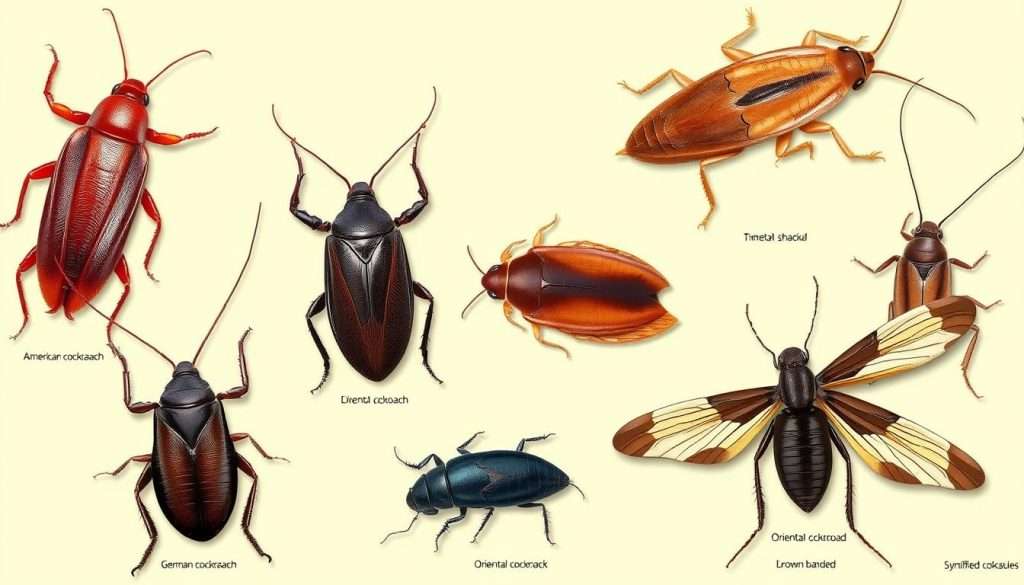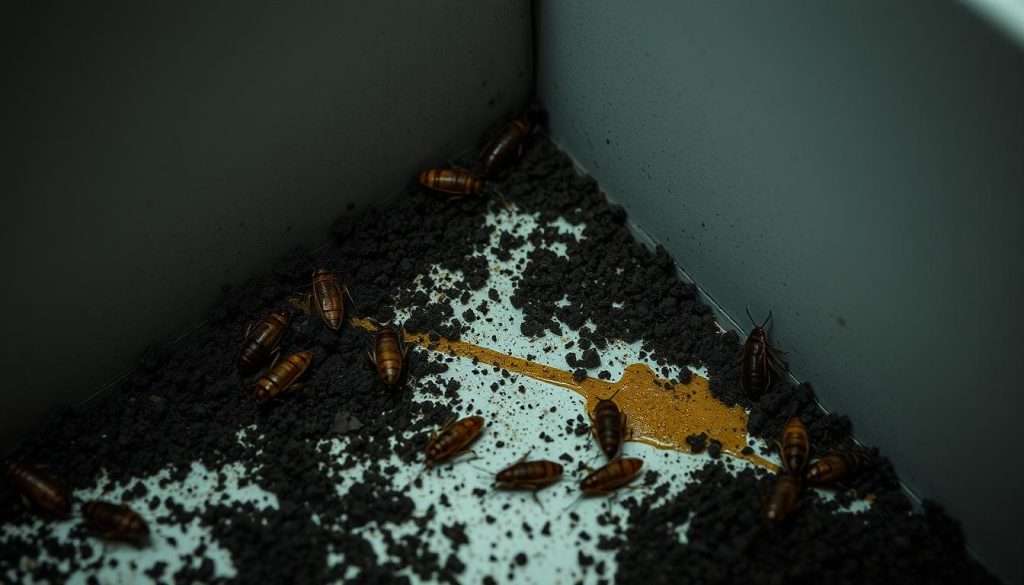Knowing how to spot a cockroach is key to controlling pests. There are over 4,000 cockroach types worldwide, with about 70 in the U.S. Spotting them early can help you tackle small problems before they get big.
Understanding the different cockroach types helps you choose the right pest control. We’ll look at the looks, actions, and homes of common cockroaches. By the end, you’ll know how to spot a cockroach and what to do about it.
Key Takeaways
- There are over 4,000 cockroach species worldwide, with about 70 in the U.S.
- Common cockroach species include the American, German, Brown-banded, and Oriental cockroach.
- Cockroaches can infest more than 120 million homes in the United States annually.
- Appearance and behavior vary significantly among cockroach species.
- Prompt identification can inform effective pest control methods.
Cockroach Basics: Understanding Their Presence
Knowing about cockroaches in your home starts with their basic traits. There are over 4,600 species worldwide, but only 55 live in the U.S. They like places with food, moisture, and shelter. Kitchens and bathrooms are their favorite spots because they are dark and damp.
The German cockroach is especially common. It reproduces quickly, making it a big problem for homeowners.
Cockroach infestations mean your home is not clean. They can spread diseases by carrying bacteria on their bodies. Female German cockroaches can lay up to 200 eggs in their lifetime.
To keep them away, know what they like. They prefer warm places and hide in cracks and clutter. They are drawn to:
- Food sources, such as crumbs and grease
- Moisture from standing water and high humidity
- Strong odors from organic materials and waste
Stopping them early is key. Keep your home clean, fix leaks, and seal cracks. Also, store food right and stay clean to keep them away.
| Cockroach Species | Size | Reproductive Capabilities |
|---|---|---|
| American Cockroach | Approximately 2 inches | Up to 6 generations per year |
| German Cockroach | ½ to ⅝ inch | 5 egg sacs, 30-40 eggs each |
| Oriental Cockroach | 1 to 1.25 inches | 200-300 offspring annually |
| Smokybrown Cockroach | 1.5 inches | Outdoors primarily, related to food availability |
By learning about cockroaches, you can control them. This makes your home cleaner and healthier.
Common Cockroach Species in the United States
Knowing about different cockroaches helps you tackle infestations better. In the U.S., many cockroach types invade homes and buildings. Here, we highlight some common ones found in homes and businesses.
German Cockroach
The German cockroach, or Blattella germanica, is the most common in homes. It’s small, growing from 1/2 to 5/8 inches long. It reproduces fast, growing from egg to adult in about 55 to 68 days.
You’ll often see them in kitchens and bathrooms. They love food and moisture.
American Cockroach
The American cockroach, or Periplaneta americana, is huge, growing up to 3 inches long. It has a yellow band behind its head. It likes commercial places but also homes.
In warmer places, it can fly well. But in Maryland, it doesn’t fly much. It’s very fast.
Oriental Cockroach
Oriental cockroaches, or Blatta orientalis, need moisture and are called water bugs. They’re dark brown and about 1.25 inches long. It takes 300 to 800 days for them to grow from egg to adult.
They can’t fly, so they like moist places.
Brown-Banded Cockroach
The Brown-Banded cockroach, or Supella longipalpa, is small, about half an inch long. It has a golden-tan band on its wings and belly. It takes 95 to 276 days for them to grow from egg to adult.

How to Identify a Cockroach: Key Characteristics
Identifying cockroaches means looking at their appearance, size, and behavior. Knowing these traits helps you spot them and take action.
Cockroach Appearance
Cockroaches have some common features. They are flat, oval-shaped, with long antennae and six legs. Here are details on some common types:
- German cockroaches: Light brown or caramel, up to ⅝ inch.
- Oriental cockroaches: Almost black, up to 1¼ inches, like dark places.
- American cockroaches: Dark brown or reddish-brown, up to 1½ inches, with wings.
Cockroach Size and Coloration
Cockroach sizes vary by type. Adults look similar but are different sizes. Knowing this helps you identify them:
| Species | Size (Inches) | Coloration |
|---|---|---|
| German | 0.5 – 0.625 | Light brown or caramel |
| Oriental | 1.25 | Nearly black |
| American | 1.5 | Dark brown or reddish-brown |
Behavioral Traits of Cockroaches
Cockroach behavior is key to spotting them at home. They are mostly active at night and like moist places:
- German cockroaches like warm spots, especially near sinks and dishwashers.
- Oriental cockroaches prefer basements, drains, and woodpiles.
- American cockroaches can fly and are often near food.
For more on cockroach species, check out this resource. Understanding their behavior helps you manage them better.
Signs of a Cockroach Infestation
Knowing the signs of a cockroach infestation is key to managing pests. Spotting these signs early helps prevent bigger problems. Look out for these common signs:
Common Infestation Indicators
- Droppings: You might find cockroach droppings that look like tiny pepper specks. A lot of feces means you have an infestation.
- Foul odors: A musty smell can come from roaches. This smell gets stronger as the infestation grows.
- Shed skins: Roaches shed their skin five to eight times. Look for these in their favorite spots.
- Smear marks: Find brown, irregular-shaped smear marks in damp areas. These are common on horizontal surfaces.
- Egg capsules: Roaches lay eggs in capsules, with up to 30 nymphs inside. Finding these means you have a big problem.
- Daytime activity: Seeing cockroaches during the day means you have a big infestation. They usually come out at night.
Tracking Down Hiding Spots
Cockroaches like dark, damp places in your home. Finding where they hide is important for controlling them. Common spots include:
- Under sinks
- Behind appliances
- Inside walls
Seeing one roach means many more are around. Because they breed fast, a single female can have lots of babies. It’s important to call pest control experts as soon as you see any signs of cockroaches.

Cockroach Control Methods and Extermination
Managing cockroaches needs a smart plan. This includes steps to stop them before they start. Knowing cockroach control methods helps you act fast.
Preventative Measures
To keep cockroaches away, try these easy steps:
- Seal cracks and crevices to prevent entry from the outside.
- Store food in airtight containers to avoid attracting these pests.
- Maintain cleanliness to eliminate crumbs and spills that might serve as food sources.
- Reduce moisture levels as cockroaches require water for survival.
- Regularly dispose of garbage and keep your environment tidy.
These pest control strategies can help keep cockroaches out.
Professional Extermination Techniques
If cockroaches show up, a pro can help. They use a detailed plan like this:
- Inspection to identify the species and extent of the infestation.
- Utilizing various tools and methods, including gel baits like Combat or Maxforce, which target the cockroaches directly.
- Applying boric acid dust in strategic locations to create long-term barriers.
- Using bait stations that are child and pet-friendly for added safety.
- Monitoring and follow-up treatments to ensure complete eradication.
Because cockroaches are tough, you might need more than one approach. A pro can make a plan just for you. For more info, check out this pest control guide.
Conclusion
Knowing how to spot cockroaches is key to keeping your home pest-free. There are many types of cockroaches, each with its own look and where it likes to live. This knowledge helps you find and deal with them fast.
Being ready to spot cockroach signs helps you stop them before they start. If you can’t handle it, experts can help get rid of them. This way, your home stays safe and healthy.
By watching for cockroaches and knowing how they act, you can control them. Regular checks and quick action help keep your home peaceful and pest-free.
